University Literature Review: Religious Satisfaction and Student Life
VerifiedAdded on 2020/02/18
|7
|1438
|328
Literature Review
AI Summary
This literature review explores the multifaceted aspects of religious satisfaction among students, particularly within the multicultural context of Australia. The review addresses research questions concerning the components of religious satisfaction, levels of religious involvement, and the impact of religion on students' lives, including behavioral changes. It highlights the role of religion in shaping cultural backgrounds and influencing student behavior, especially for students from ethnic backgrounds. The review examines how religious faith can provide a sense of identity, particularly for international students, and offers guidelines for an honorable life. Furthermore, it delves into the prerequisites for religious satisfaction, such as spaces for worship and the freedom to practice without judgment. The review also touches on the connection between religion and coping mechanisms, stress relief, and healthy lifestyles, including how religious symptoms can positively influence students in higher education and help them cope with depression and substance abuse. Several sources are referenced to support these claims.
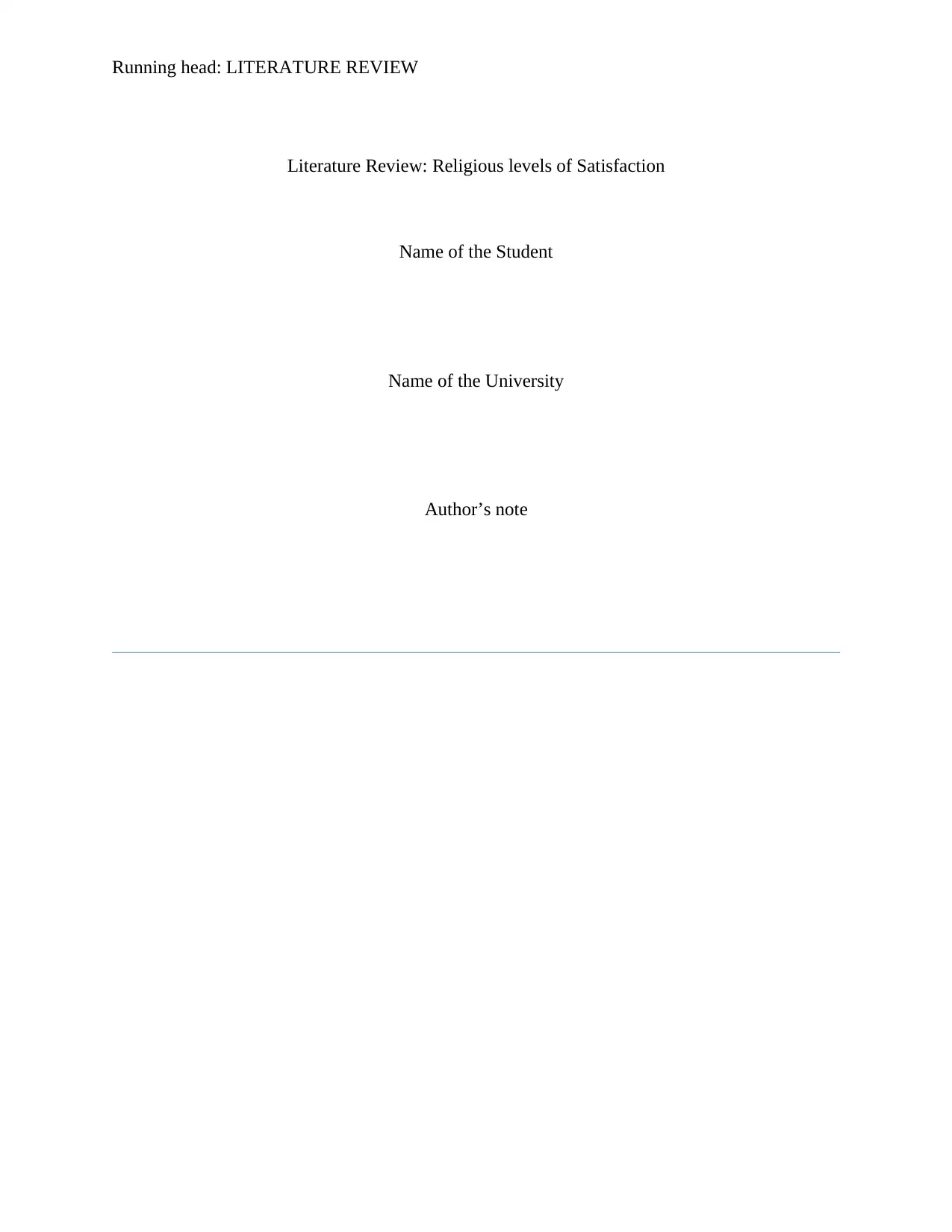
Running head: LITERATURE REVIEW
Literature Review: Religious levels of Satisfaction
Name of the Student
Name of the University
Author’s note
Literature Review: Religious levels of Satisfaction
Name of the Student
Name of the University
Author’s note
Paraphrase This Document
Need a fresh take? Get an instant paraphrase of this document with our AI Paraphraser
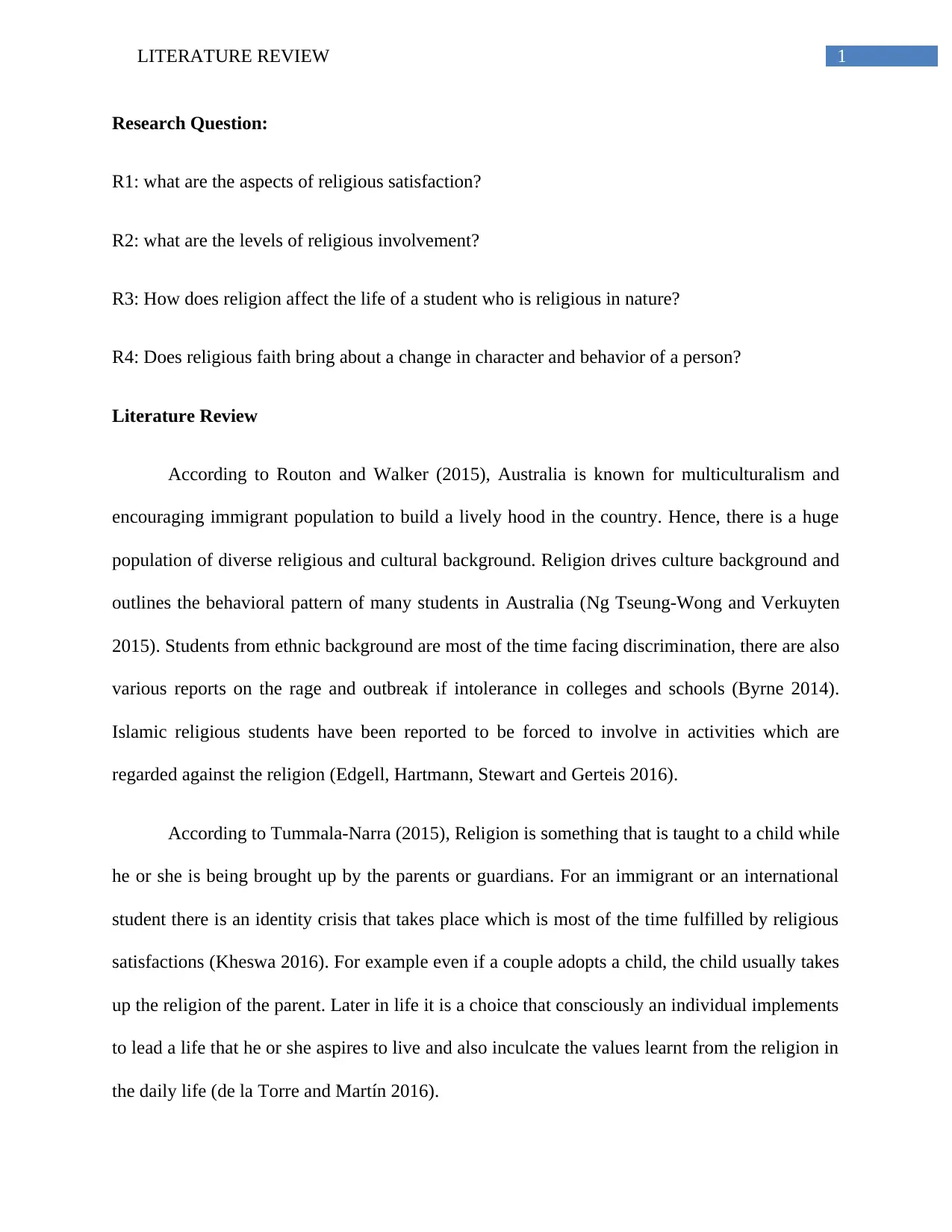
1LITERATURE REVIEW
Research Question:
R1: what are the aspects of religious satisfaction?
R2: what are the levels of religious involvement?
R3: How does religion affect the life of a student who is religious in nature?
R4: Does religious faith bring about a change in character and behavior of a person?
Literature Review
According to Routon and Walker (2015), Australia is known for multiculturalism and
encouraging immigrant population to build a lively hood in the country. Hence, there is a huge
population of diverse religious and cultural background. Religion drives culture background and
outlines the behavioral pattern of many students in Australia (Ng Tseung-Wong and Verkuyten
2015). Students from ethnic background are most of the time facing discrimination, there are also
various reports on the rage and outbreak if intolerance in colleges and schools (Byrne 2014).
Islamic religious students have been reported to be forced to involve in activities which are
regarded against the religion (Edgell, Hartmann, Stewart and Gerteis 2016).
According to Tummala-Narra (2015), Religion is something that is taught to a child while
he or she is being brought up by the parents or guardians. For an immigrant or an international
student there is an identity crisis that takes place which is most of the time fulfilled by religious
satisfactions (Kheswa 2016). For example even if a couple adopts a child, the child usually takes
up the religion of the parent. Later in life it is a choice that consciously an individual implements
to lead a life that he or she aspires to live and also inculcate the values learnt from the religion in
the daily life (de la Torre and Martín 2016).
Research Question:
R1: what are the aspects of religious satisfaction?
R2: what are the levels of religious involvement?
R3: How does religion affect the life of a student who is religious in nature?
R4: Does religious faith bring about a change in character and behavior of a person?
Literature Review
According to Routon and Walker (2015), Australia is known for multiculturalism and
encouraging immigrant population to build a lively hood in the country. Hence, there is a huge
population of diverse religious and cultural background. Religion drives culture background and
outlines the behavioral pattern of many students in Australia (Ng Tseung-Wong and Verkuyten
2015). Students from ethnic background are most of the time facing discrimination, there are also
various reports on the rage and outbreak if intolerance in colleges and schools (Byrne 2014).
Islamic religious students have been reported to be forced to involve in activities which are
regarded against the religion (Edgell, Hartmann, Stewart and Gerteis 2016).
According to Tummala-Narra (2015), Religion is something that is taught to a child while
he or she is being brought up by the parents or guardians. For an immigrant or an international
student there is an identity crisis that takes place which is most of the time fulfilled by religious
satisfactions (Kheswa 2016). For example even if a couple adopts a child, the child usually takes
up the religion of the parent. Later in life it is a choice that consciously an individual implements
to lead a life that he or she aspires to live and also inculcate the values learnt from the religion in
the daily life (de la Torre and Martín 2016).
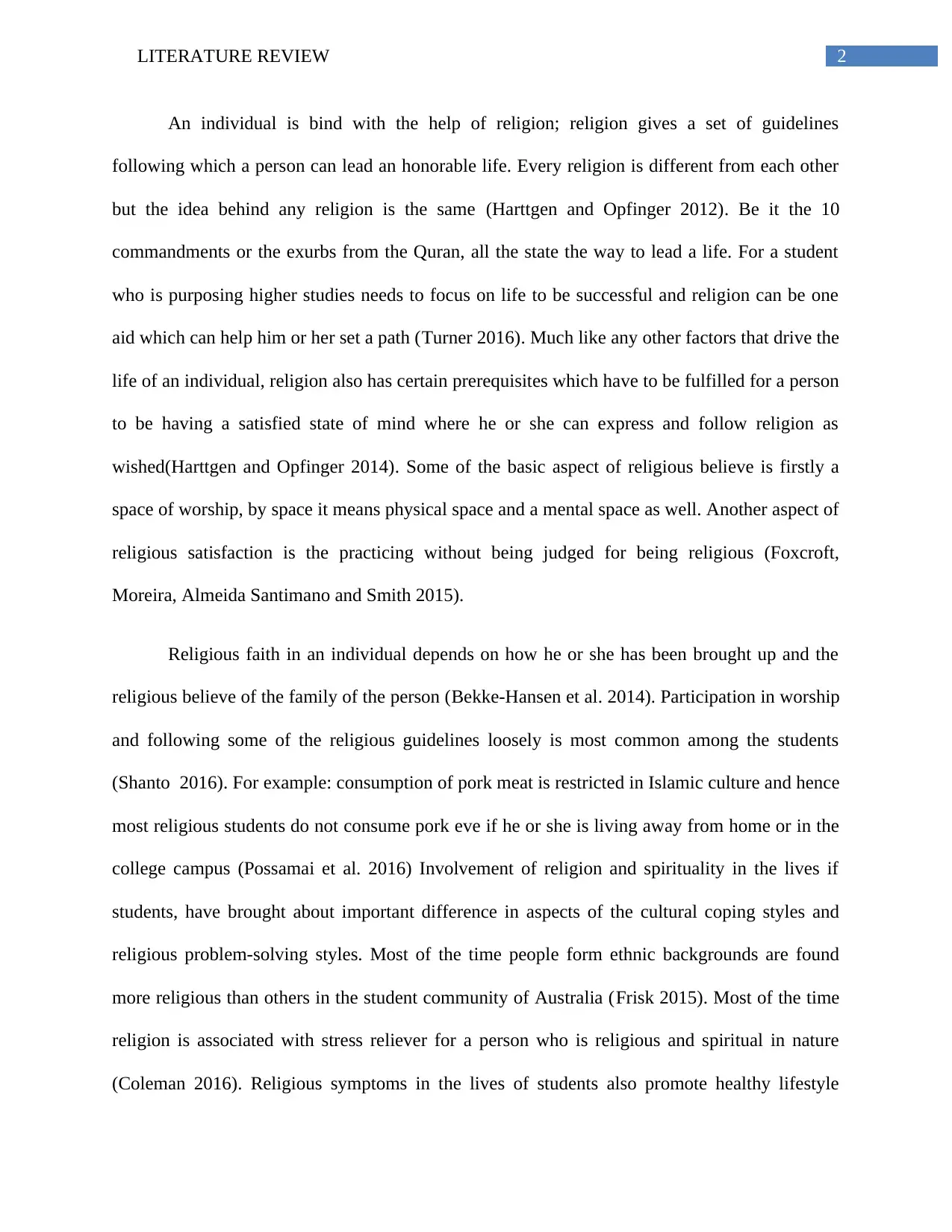
2LITERATURE REVIEW
An individual is bind with the help of religion; religion gives a set of guidelines
following which a person can lead an honorable life. Every religion is different from each other
but the idea behind any religion is the same (Harttgen and Opfinger 2012). Be it the 10
commandments or the exurbs from the Quran, all the state the way to lead a life. For a student
who is purposing higher studies needs to focus on life to be successful and religion can be one
aid which can help him or her set a path (Turner 2016). Much like any other factors that drive the
life of an individual, religion also has certain prerequisites which have to be fulfilled for a person
to be having a satisfied state of mind where he or she can express and follow religion as
wished(Harttgen and Opfinger 2014). Some of the basic aspect of religious believe is firstly a
space of worship, by space it means physical space and a mental space as well. Another aspect of
religious satisfaction is the practicing without being judged for being religious (Foxcroft,
Moreira, Almeida Santimano and Smith 2015).
Religious faith in an individual depends on how he or she has been brought up and the
religious believe of the family of the person (Bekke-Hansen et al. 2014). Participation in worship
and following some of the religious guidelines loosely is most common among the students
(Shanto 2016). For example: consumption of pork meat is restricted in Islamic culture and hence
most religious students do not consume pork eve if he or she is living away from home or in the
college campus (Possamai et al. 2016) Involvement of religion and spirituality in the lives if
students, have brought about important difference in aspects of the cultural coping styles and
religious problem-solving styles. Most of the time people form ethnic backgrounds are found
more religious than others in the student community of Australia (Frisk 2015). Most of the time
religion is associated with stress reliever for a person who is religious and spiritual in nature
(Coleman 2016). Religious symptoms in the lives of students also promote healthy lifestyle
An individual is bind with the help of religion; religion gives a set of guidelines
following which a person can lead an honorable life. Every religion is different from each other
but the idea behind any religion is the same (Harttgen and Opfinger 2012). Be it the 10
commandments or the exurbs from the Quran, all the state the way to lead a life. For a student
who is purposing higher studies needs to focus on life to be successful and religion can be one
aid which can help him or her set a path (Turner 2016). Much like any other factors that drive the
life of an individual, religion also has certain prerequisites which have to be fulfilled for a person
to be having a satisfied state of mind where he or she can express and follow religion as
wished(Harttgen and Opfinger 2014). Some of the basic aspect of religious believe is firstly a
space of worship, by space it means physical space and a mental space as well. Another aspect of
religious satisfaction is the practicing without being judged for being religious (Foxcroft,
Moreira, Almeida Santimano and Smith 2015).
Religious faith in an individual depends on how he or she has been brought up and the
religious believe of the family of the person (Bekke-Hansen et al. 2014). Participation in worship
and following some of the religious guidelines loosely is most common among the students
(Shanto 2016). For example: consumption of pork meat is restricted in Islamic culture and hence
most religious students do not consume pork eve if he or she is living away from home or in the
college campus (Possamai et al. 2016) Involvement of religion and spirituality in the lives if
students, have brought about important difference in aspects of the cultural coping styles and
religious problem-solving styles. Most of the time people form ethnic backgrounds are found
more religious than others in the student community of Australia (Frisk 2015). Most of the time
religion is associated with stress reliever for a person who is religious and spiritual in nature
(Coleman 2016). Religious symptoms in the lives of students also promote healthy lifestyle
⊘ This is a preview!⊘
Do you want full access?
Subscribe today to unlock all pages.

Trusted by 1+ million students worldwide
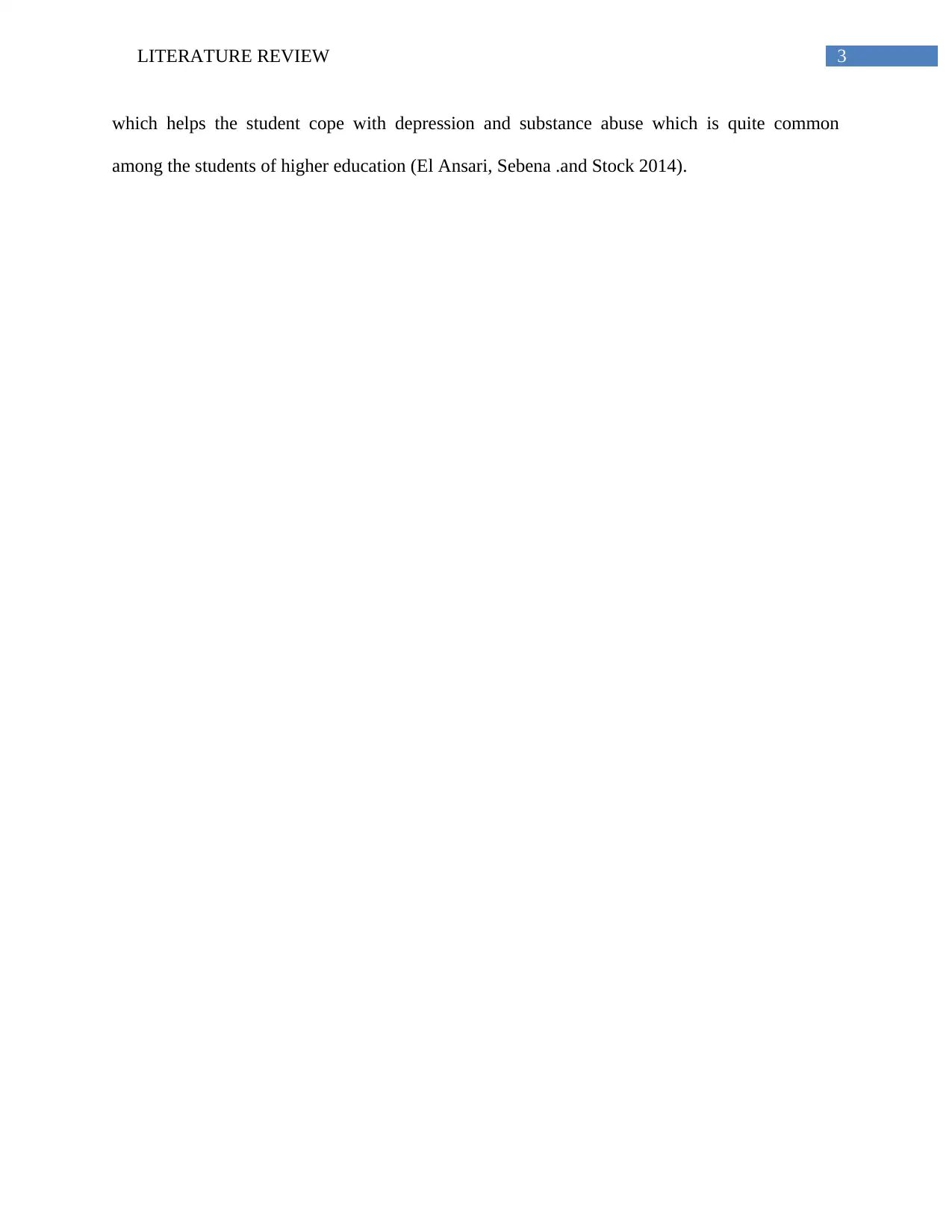
3LITERATURE REVIEW
which helps the student cope with depression and substance abuse which is quite common
among the students of higher education (El Ansari, Sebena .and Stock 2014).
which helps the student cope with depression and substance abuse which is quite common
among the students of higher education (El Ansari, Sebena .and Stock 2014).
Paraphrase This Document
Need a fresh take? Get an instant paraphrase of this document with our AI Paraphraser
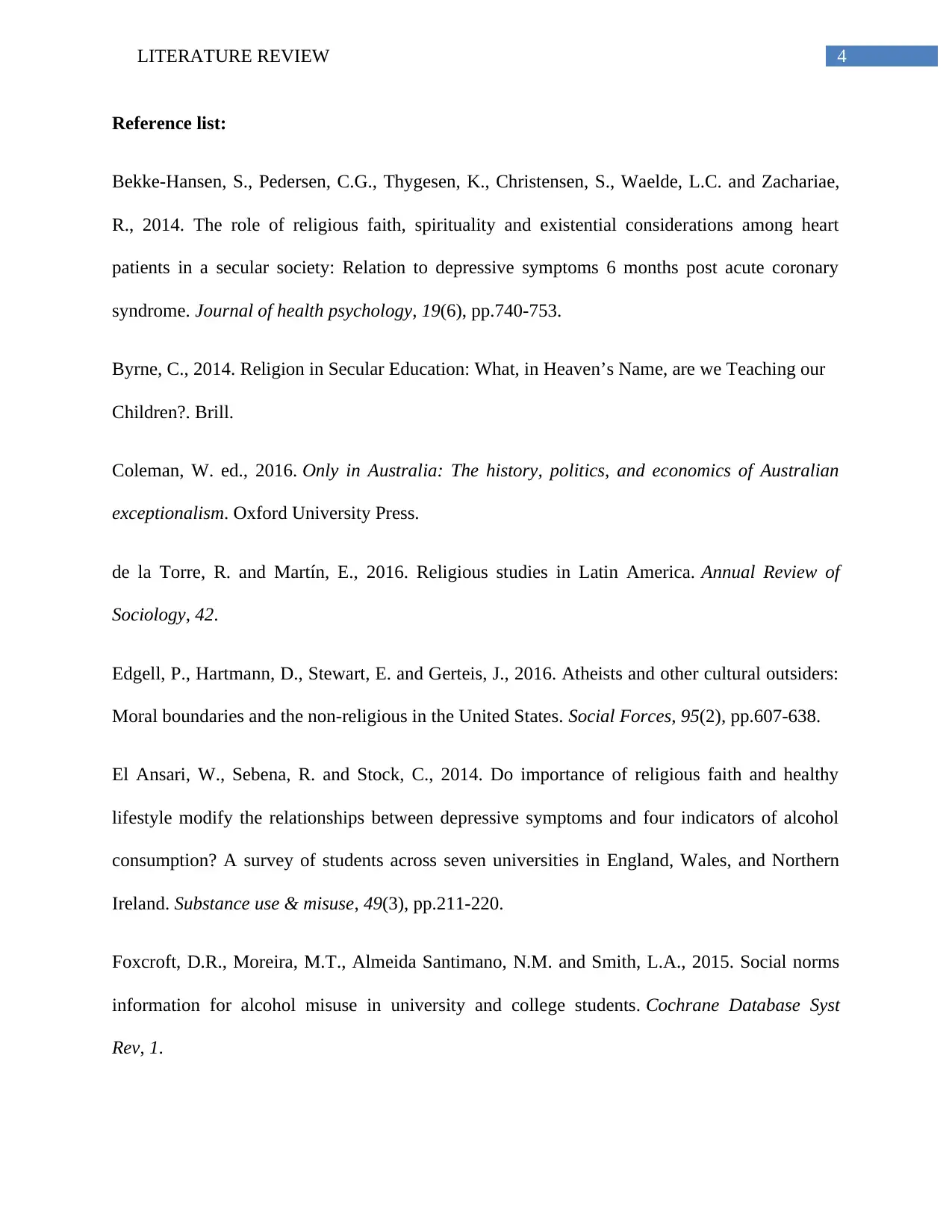
4LITERATURE REVIEW
Reference list:
Bekke-Hansen, S., Pedersen, C.G., Thygesen, K., Christensen, S., Waelde, L.C. and Zachariae,
R., 2014. The role of religious faith, spirituality and existential considerations among heart
patients in a secular society: Relation to depressive symptoms 6 months post acute coronary
syndrome. Journal of health psychology, 19(6), pp.740-753.
Byrne, C., 2014. Religion in Secular Education: What, in Heaven’s Name, are we Teaching our
Children?. Brill.
Coleman, W. ed., 2016. Only in Australia: The history, politics, and economics of Australian
exceptionalism. Oxford University Press.
de la Torre, R. and Martín, E., 2016. Religious studies in Latin America. Annual Review of
Sociology, 42.
Edgell, P., Hartmann, D., Stewart, E. and Gerteis, J., 2016. Atheists and other cultural outsiders:
Moral boundaries and the non-religious in the United States. Social Forces, 95(2), pp.607-638.
El Ansari, W., Sebena, R. and Stock, C., 2014. Do importance of religious faith and healthy
lifestyle modify the relationships between depressive symptoms and four indicators of alcohol
consumption? A survey of students across seven universities in England, Wales, and Northern
Ireland. Substance use & misuse, 49(3), pp.211-220.
Foxcroft, D.R., Moreira, M.T., Almeida Santimano, N.M. and Smith, L.A., 2015. Social norms
information for alcohol misuse in university and college students. Cochrane Database Syst
Rev, 1.
Reference list:
Bekke-Hansen, S., Pedersen, C.G., Thygesen, K., Christensen, S., Waelde, L.C. and Zachariae,
R., 2014. The role of religious faith, spirituality and existential considerations among heart
patients in a secular society: Relation to depressive symptoms 6 months post acute coronary
syndrome. Journal of health psychology, 19(6), pp.740-753.
Byrne, C., 2014. Religion in Secular Education: What, in Heaven’s Name, are we Teaching our
Children?. Brill.
Coleman, W. ed., 2016. Only in Australia: The history, politics, and economics of Australian
exceptionalism. Oxford University Press.
de la Torre, R. and Martín, E., 2016. Religious studies in Latin America. Annual Review of
Sociology, 42.
Edgell, P., Hartmann, D., Stewart, E. and Gerteis, J., 2016. Atheists and other cultural outsiders:
Moral boundaries and the non-religious in the United States. Social Forces, 95(2), pp.607-638.
El Ansari, W., Sebena, R. and Stock, C., 2014. Do importance of religious faith and healthy
lifestyle modify the relationships between depressive symptoms and four indicators of alcohol
consumption? A survey of students across seven universities in England, Wales, and Northern
Ireland. Substance use & misuse, 49(3), pp.211-220.
Foxcroft, D.R., Moreira, M.T., Almeida Santimano, N.M. and Smith, L.A., 2015. Social norms
information for alcohol misuse in university and college students. Cochrane Database Syst
Rev, 1.
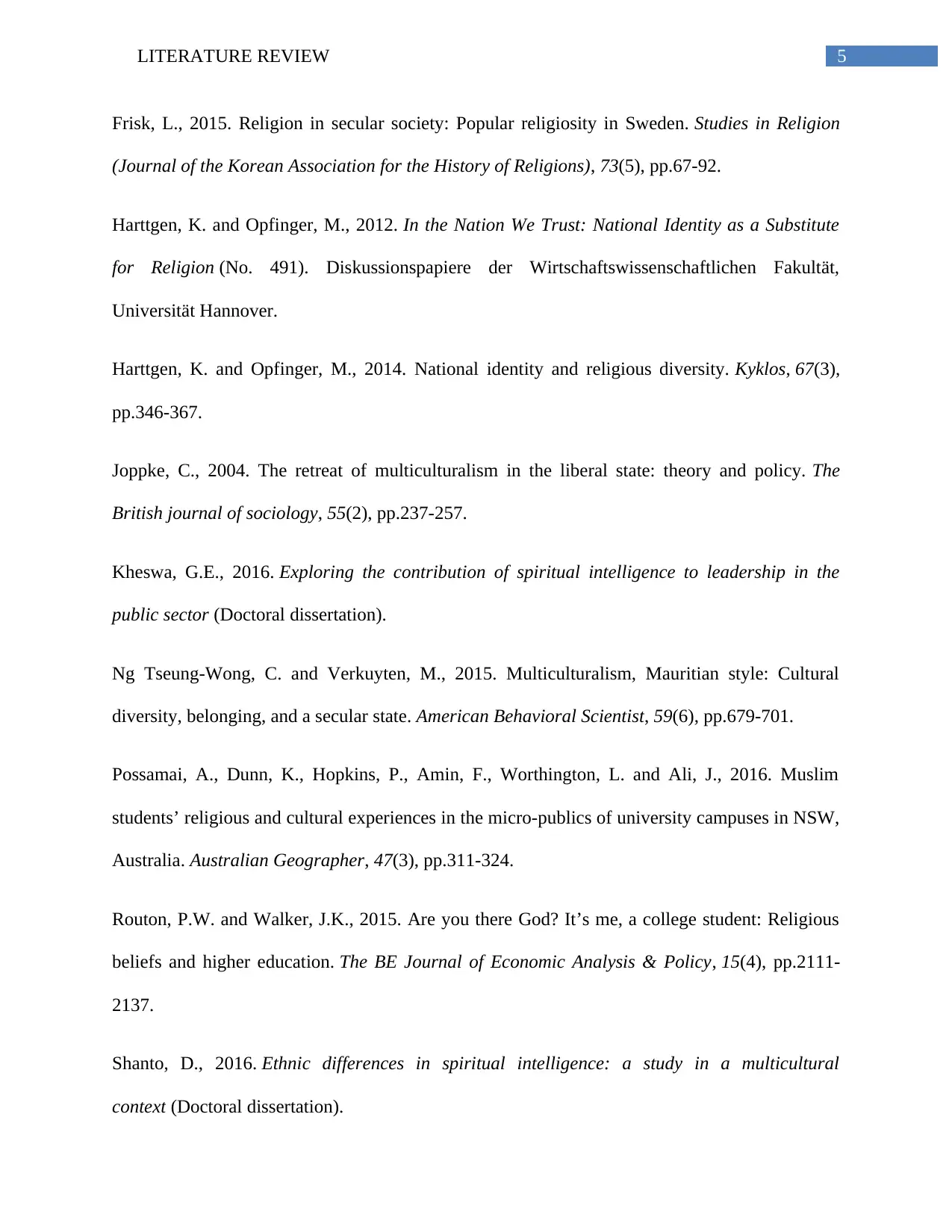
5LITERATURE REVIEW
Frisk, L., 2015. Religion in secular society: Popular religiosity in Sweden. Studies in Religion
(Journal of the Korean Association for the History of Religions), 73(5), pp.67-92.
Harttgen, K. and Opfinger, M., 2012. In the Nation We Trust: National Identity as a Substitute
for Religion (No. 491). Diskussionspapiere der Wirtschaftswissenschaftlichen Fakultät,
Universität Hannover.
Harttgen, K. and Opfinger, M., 2014. National identity and religious diversity. Kyklos, 67(3),
pp.346-367.
Joppke, C., 2004. The retreat of multiculturalism in the liberal state: theory and policy. The
British journal of sociology, 55(2), pp.237-257.
Kheswa, G.E., 2016. Exploring the contribution of spiritual intelligence to leadership in the
public sector (Doctoral dissertation).
Ng Tseung-Wong, C. and Verkuyten, M., 2015. Multiculturalism, Mauritian style: Cultural
diversity, belonging, and a secular state. American Behavioral Scientist, 59(6), pp.679-701.
Possamai, A., Dunn, K., Hopkins, P., Amin, F., Worthington, L. and Ali, J., 2016. Muslim
students’ religious and cultural experiences in the micro-publics of university campuses in NSW,
Australia. Australian Geographer, 47(3), pp.311-324.
Routon, P.W. and Walker, J.K., 2015. Are you there God? It’s me, a college student: Religious
beliefs and higher education. The BE Journal of Economic Analysis & Policy, 15(4), pp.2111-
2137.
Shanto, D., 2016. Ethnic differences in spiritual intelligence: a study in a multicultural
context (Doctoral dissertation).
Frisk, L., 2015. Religion in secular society: Popular religiosity in Sweden. Studies in Religion
(Journal of the Korean Association for the History of Religions), 73(5), pp.67-92.
Harttgen, K. and Opfinger, M., 2012. In the Nation We Trust: National Identity as a Substitute
for Religion (No. 491). Diskussionspapiere der Wirtschaftswissenschaftlichen Fakultät,
Universität Hannover.
Harttgen, K. and Opfinger, M., 2014. National identity and religious diversity. Kyklos, 67(3),
pp.346-367.
Joppke, C., 2004. The retreat of multiculturalism in the liberal state: theory and policy. The
British journal of sociology, 55(2), pp.237-257.
Kheswa, G.E., 2016. Exploring the contribution of spiritual intelligence to leadership in the
public sector (Doctoral dissertation).
Ng Tseung-Wong, C. and Verkuyten, M., 2015. Multiculturalism, Mauritian style: Cultural
diversity, belonging, and a secular state. American Behavioral Scientist, 59(6), pp.679-701.
Possamai, A., Dunn, K., Hopkins, P., Amin, F., Worthington, L. and Ali, J., 2016. Muslim
students’ religious and cultural experiences in the micro-publics of university campuses in NSW,
Australia. Australian Geographer, 47(3), pp.311-324.
Routon, P.W. and Walker, J.K., 2015. Are you there God? It’s me, a college student: Religious
beliefs and higher education. The BE Journal of Economic Analysis & Policy, 15(4), pp.2111-
2137.
Shanto, D., 2016. Ethnic differences in spiritual intelligence: a study in a multicultural
context (Doctoral dissertation).
⊘ This is a preview!⊘
Do you want full access?
Subscribe today to unlock all pages.

Trusted by 1+ million students worldwide
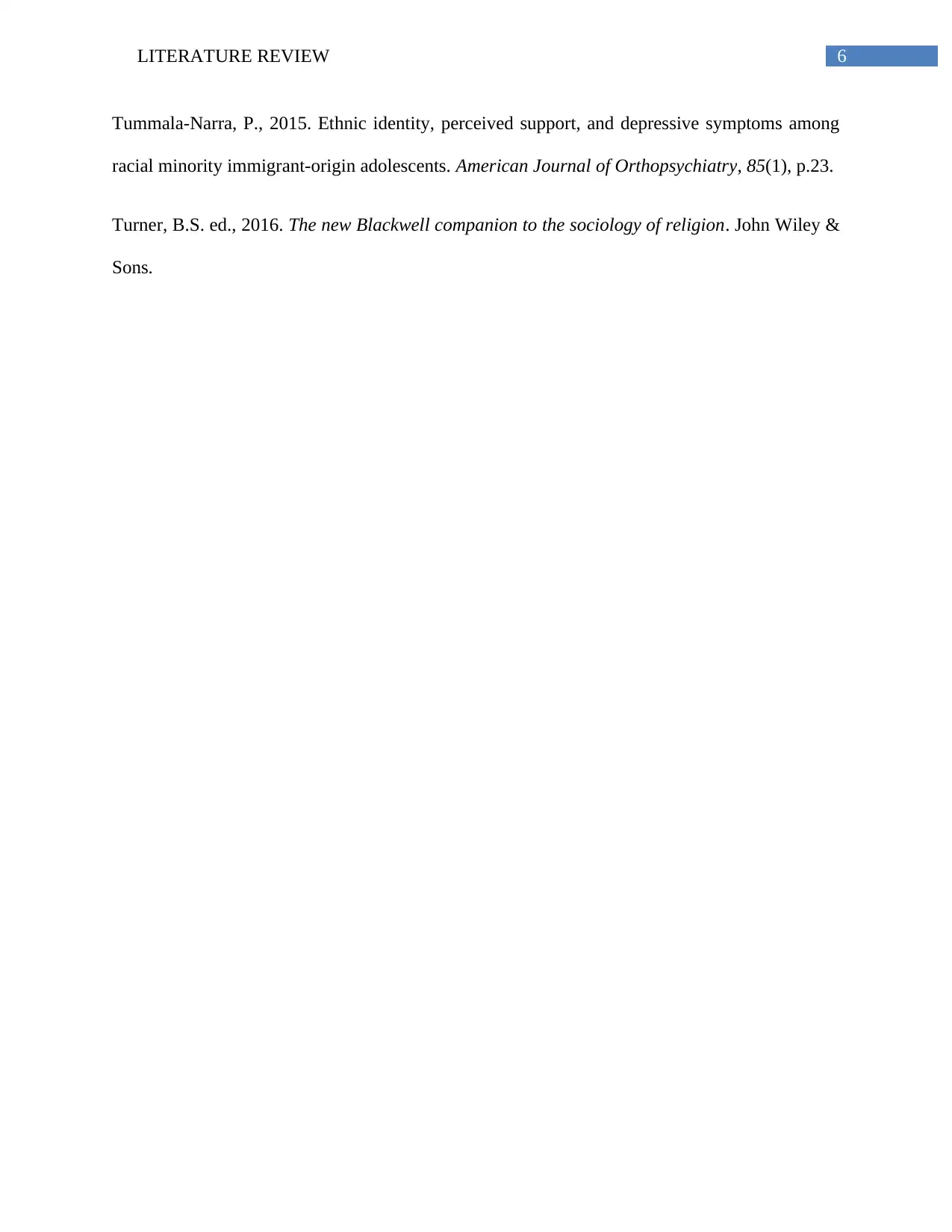
6LITERATURE REVIEW
Tummala-Narra, P., 2015. Ethnic identity, perceived support, and depressive symptoms among
racial minority immigrant-origin adolescents. American Journal of Orthopsychiatry, 85(1), p.23.
Turner, B.S. ed., 2016. The new Blackwell companion to the sociology of religion. John Wiley &
Sons.
Tummala-Narra, P., 2015. Ethnic identity, perceived support, and depressive symptoms among
racial minority immigrant-origin adolescents. American Journal of Orthopsychiatry, 85(1), p.23.
Turner, B.S. ed., 2016. The new Blackwell companion to the sociology of religion. John Wiley &
Sons.
1 out of 7
Related Documents
Your All-in-One AI-Powered Toolkit for Academic Success.
+13062052269
info@desklib.com
Available 24*7 on WhatsApp / Email
![[object Object]](/_next/static/media/star-bottom.7253800d.svg)
Unlock your academic potential
Copyright © 2020–2025 A2Z Services. All Rights Reserved. Developed and managed by ZUCOL.




